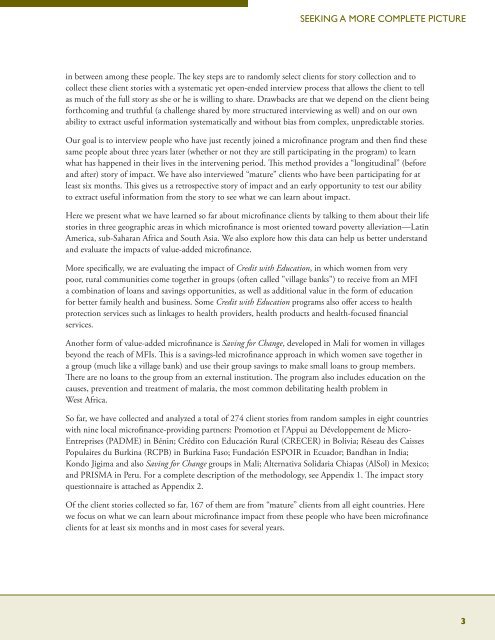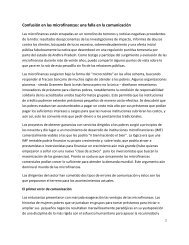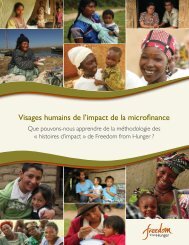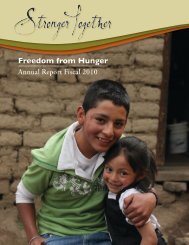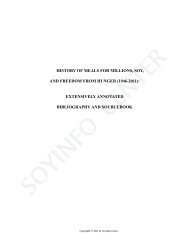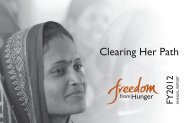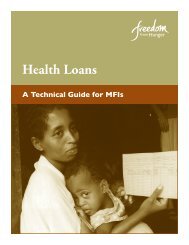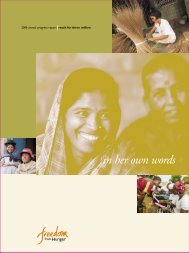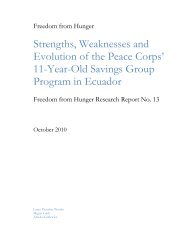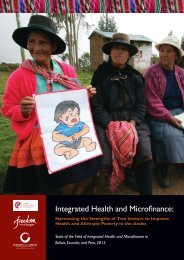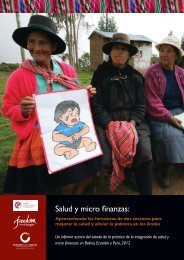English - Freedom from Hunger
English - Freedom from Hunger
English - Freedom from Hunger
Create successful ePaper yourself
Turn your PDF publications into a flip-book with our unique Google optimized e-Paper software.
seekIng a MoRe CoMPleTe PICTuRe<br />
in between among these people. The key steps are to randomly select clients for story collection and to<br />
collect these client stories with a systematic yet open-ended interview process that allows the client to tell<br />
as much of the full story as she or he is willing to share. Drawbacks are that we depend on the client being<br />
forthcoming and truthful (a challenge shared by more structured interviewing as well) and on our own<br />
ability to extract useful information systematically and without bias <strong>from</strong> complex, unpredictable stories.<br />
Our goal is to interview people who have just recently joined a microfinance program and then find these<br />
same people about three years later (whether or not they are still participating in the program) to learn<br />
what has happened in their lives in the intervening period. This method provides a “longitudinal” (before<br />
and after) story of impact. We have also interviewed “mature” clients who have been participating for at<br />
least six months. This gives us a retrospective story of impact and an early opportunity to test our ability<br />
to extract useful information <strong>from</strong> the story to see what we can learn about impact.<br />
Here we present what we have learned so far about microfinance clients by talking to them about their life<br />
stories in three geographic areas in which microfinance is most oriented toward poverty alleviation—Latin<br />
America, sub-Saharan Africa and South Asia. We also explore how this data can help us better understand<br />
and evaluate the impacts of value-added microfinance.<br />
More specifically, we are evaluating the impact of Credit with Education, in which women <strong>from</strong> very<br />
poor, rural communities come together in groups (often called "village banks") to receive <strong>from</strong> an MFI<br />
a combination of loans and savings opportunities, as well as additional value in the form of education<br />
for better family health and business. Some Credit with Education programs also offer access to health<br />
protection services such as linkages to health providers, health products and health-focused financial<br />
services.<br />
Another form of value-added microfinance is Saving for Change, developed in Mali for women in villages<br />
beyond the reach of MFIs. This is a savings-led microfinance approach in which women save together in<br />
a group (much like a village bank) and use their group savings to make small loans to group members.<br />
There are no loans to the group <strong>from</strong> an external institution. The program also includes education on the<br />
causes, prevention and treatment of malaria, the most common debilitating health problem in<br />
West Africa.<br />
So far, we have collected and analyzed a total of 274 client stories <strong>from</strong> random samples in eight countries<br />
with nine local microfinance-providing partners: Promotion et l’Appui au Développement de Micro-<br />
Entreprises (PADME) in Bénin; Crédito con Educación Rural (CRECER) in Bolivia; Réseau des Caisses<br />
Populaires du Burkina (RCPB) in Burkina Faso; Fundación ESPOIR in Ecuador; Bandhan in India;<br />
Kondo Jigima and also Saving for Change groups in Mali; Alternativa Solidaria Chiapas (AlSol) in Mexico;<br />
and PRISMA in Peru. For a complete description of the methodology, see Appendix 1. The impact story<br />
questionnaire is attached as Appendix 2.<br />
Of the client stories collected so far, 167 of them are <strong>from</strong> “mature” clients <strong>from</strong> all eight countries. Here<br />
we focus on what we can learn about microfinance impact <strong>from</strong> these people who have been microfinance<br />
clients for at least six months and in most cases for several years.<br />
3


